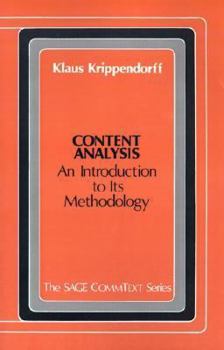Content Analysis: An Introduction to Methodology
(Part of the Commtext Series Series)
Select Format
Select Condition 
Book Overview
What matters in people's social lives? What motivates and inspires our society? How do we enact what we know? Since the first edition published in 1980, Content Analysis has helped shape and define... This description may be from another edition of this product.
Format:Paperback
Language:English
ISBN:0803914989
ISBN13:9780803914988
Release Date:September 1980
Publisher:Sage Publications, Inc
Length:189 Pages
Weight:0.62 lbs.
Dimensions:0.5" x 5.5" x 8.3"
Customer Reviews
4 ratings
The Leading Content Analysis Methods Reference
Published by Thriftbooks.com User , 16 years ago
Klaus Krippendorff has updated his influential treatment of content analysis methodology (Content Analysis: An Introduction to Its Methodology). The author acknowledges that two decades have changed how content analysts work. Changes include the pervasiveness of computers, diffusion of content analysis methods to other disciplines, large text archives on the web, and increased coordination between teams of analysts. The 14 chapters are organized into three sections that present foundational material, content analysis design, and analysis and interpretation. The author begins with the history of content analysis. He includes well-chosen examples ranging from its origins in Renaissance analysis of religious texts, through early 20th century focus on newspapers, World War II concerns with propaganda, and postwar expansion into broadcast media and advertising. Starting in the sixties, he chronicles the emerging influence of computers, electronic storage, and the web. His review of computer-aided content analysis tools does not descend into "shoot-out" feature comparisons, but develops a framework based on how they support the researcher. Adopting a cautionary tone about the limits of computers, Krippendorff distinguishes between simple text management and search tools, computer-aided content analysis software such as WordStat and DICTION (Campaign Talk: Why Elections Are Good for Us), and interpretive aids such as NUD*IST used by qualitative researchers. He emphasizes semantic validity--the need for computer generated solutions to be validated by informed human judgement--and proposes strategies for establishing it. He distinguishes between research projects motivated by knowledge-driven research questions, and those motivated primarily by availability of software tools. Tool-driven approaches merit extra scrutiny because of the possibility that researchers will pursue them carelessly. The book contains some fascinating case studies. My favorite is the subtle differences in meaning of the word "rights" as used by Republicans versus Democrats (p. 266). Researchers will also appreciate his list of large electronic text archives (p. 274) and his guidance for building content dictionaries (p. 287). The review includes not only dictionary approaches, but statistical association, semantic networks, and "memetic" strategies (p.299) which trace the flow of ideas between documents--such as cascades of newsgroup messages and genealogies of plagiarized college essays. The author speculates about future innovations from computational linguistics, artificial intelligence, and the commercial marketplace. This book is the classic methods reference on content analysis by one of the field's senior researchers. Content analysts are its natural audience, but it should be read by computer text analysts, too. Not for its perspective on software, which is limited, but for a much-needed research design perspective on the disciplined analysis of text.
Great
Published by Thriftbooks.com User , 16 years ago
This book helps me alot on my research about corporate environmental disclosure in financial reporting.
Masterpiece in Content Analysis literature
Published by Thriftbooks.com User , 17 years ago
This is a masterpiece by a leading scholar. Of course, absolute beginners are suggested to first read some other introductory (better more than one ;-) ) text on content analysis, because this book is quite advanced (even though the title tells that it is an introduction...) and discusses issues that would not sometimes be comprehended without having some prior knowledge and range of perspectives in the field. Otherwise, it is thorough, reflexive and innovative, always making you think and argue with the writer while reading.
Very thorough - but lamentable when it comes to discussing Text/Content Analysis Softwares.
Published by Thriftbooks.com User , 18 years ago
This is an excellent book that could have earned its fifth star if the author had nudged the content somewhat closer to the world of practical research. There's tons of good theory here, and I'm glad the author has included a history of content analysis also - but I felt the author didn't fully address the exigencies of the practical market or social researcher. Among the many uses of content analysis under discussion, the researchers' use of verbatims from surveys, or the analysis of transcripts from focus groups each receive only a glancing reference. Still, Krippendorff discusses the subject with a lot more depth than an analyst might anticipate - after all codifying and measuring the subtle nuances of text (with respect to its context) is not a black and white matter of doing word counts and bar graphs. Where this volume loses a star is on the subject of computer assisted text analysis (CATA). Here, Krippendorff cops out, stating that software evolution has been rapid, (true!) but then referring us to papers written in...1995. This is not good enough: not when the jacket says this edition includes "new information on computer-aided text analysis." Content Analysis was published in 2004 after all. Grrr! But that's one star off, and it simply means that if you want a user guide to softwares, and how to employ these, then you need to look elsewhere. A simple Google search on Text Analysis Softwares will yield what you may need. Overall, to be fair, Krippendorff sticks to the subtitle and gives us "an introduction to methodology" and this means that the book stays mostly in theoretical territory. The territory is extensive enough however for researchers who really want to grapple with the complexities of this as one of the very richest areas of cultural or marketing research. In summary, I feel a more user-oriented, (and stylistically more lively,) guide has yet to be written. In the meantime this lays a thorough foundation that is well worth a read. Put on your 'specialist' hat.






